Research Division EED/Controls Software<P>
Release Note 103.1<P>
Epicure Device Property And Attribute Definitions
Research Division EED/Controls Software
Release Note 103.1
Epicure Device Property And Attribute Definitions
David M. Kline
FORWARD: This document supersedes the information on device properties and
attributes given in Part II, Chapter 19 of the Epicure User's Guide -
Application Programmer's Guide.
Contents
The Database System
The Epicure Distributed Database system (EDDS) supports the source and OA/LAL databases
that contains information about devices. The source database is implemented as a set of
RMS files and allows modification of devices through the DB-Editor application
 . The OA/LAL
databases are derived from the source database by a transformation program (SOAL) which
extracts and reformats the data. The data are accessed by using the Epicure db_ service routines.
The data returned by the services are used by the data acquisition subsystem to construct and
process data requests. It specifies the data storage, access protocol,
and the service routine that implements the protocol. The OA/LAL databases are organized for efficient
access whereas the source database is organized as to facilitate device modification and
reporting
. The OA/LAL
databases are derived from the source database by a transformation program (SOAL) which
extracts and reformats the data. The data are accessed by using the Epicure db_ service routines.
The data returned by the services are used by the data acquisition subsystem to construct and
process data requests. It specifies the data storage, access protocol,
and the service routine that implements the protocol. The OA/LAL databases are organized for efficient
access whereas the source database is organized as to facilitate device modification and
reporting
 .
.
The database system is both centralized and distributed. It is centralized
by providing a single server process (DBSAServer) which is a focal point for database
modifications. All applications use the dbsa_ UTI
 to connect to the server,
request database modifications, and build OA/LAL databases.
The system is distributed by placing multiple copies of the OA/LAL databases
on destinations about the network. Those destinations which require efficient access
for data acquisition have their own local copy; other ones can access the OA/LAL
resident on a ``nearby'' destination
to connect to the server,
request database modifications, and build OA/LAL databases.
The system is distributed by placing multiple copies of the OA/LAL databases
on destinations about the network. Those destinations which require efficient access
for data acquisition have their own local copy; other ones can access the OA/LAL
resident on a ``nearby'' destination
 .
.
Devices
Every device has a textual name and a numeric identifier. The numeric identifier
is the device index or DI property. It is chosen sequentially and is represented as a 32-bit
integer. The device name, or NAME property, represents a device text identifier and is
implemented as a 12 character fixed-length string, left justified and padded with spaces.
Both DI or NAME may be used to lookup device information using either db_ or dbsa_
service routines. Since the DI is a 32-bit integer, it represents an efficient key
to access device information.
Properties & Attributes
Each device exhibits several fundamental properties. At the minimum, a device
is assigned both DI and NAME properties. In some sense the properties represent items which
may be read from or written to the device. Properties are defined by a property code and are
system-wide definitions and applicable across all devices. This does not mean that all
devices have all the defined properties, only that the identical property code selects the same
property for every device having that property.
Some properties require auxiliary information which does not belong in the category
of any other property. Because this information is associated directly with
a specific property of the device and not with the device as a whole, it is called an
``attribute''. Example of such attributes are items such as scaling constants which are associated
with the READING and SETTING properties of devices with the appropriate A/D or D/A-like channels.
Attributes are defined by an attribute code, and are specific to a property, so that the same
attribute code may mean different things for different properties. A property can be thought of
as a record of information about the device and an attribute as a field of that record.
Below provides a description of the device properties which may be assigned to
a device.
- DI
- The device index is an arbitrary numeric identifier and is used
as a key to access the device information from the source and OA/LAL databases.
The DI is a property to allow the name-to-DI and DI-to-name conversions as implemented by the
dbsa_ UTI database service request
 .
.
- NAME
- This is a text representation of a device and is the human equivalent
of the DI. The NAME property is used as a key to access devices from the source
and OA/LAL databases. The text string indicates beamline, device type, and location of the device
according to a nomenclature standard. The standard is maintained by the Site Operations
Department and described in the document ``Conventions used by E.A.D.''
- CLASS
- The device class categorizes the device for the data acquisition subsystem
and application programs. Below describes the available classes:
- Normal
- A standard device which represents a piece of hardware that is accessible
through the data acquisition system.
- Synthetic
- The synthetic device is not a real, or physical device but represents
a value that is a function of the present readings of one or more device's. The data acquisition subsystem
uses mathematical relation stored in the database to connect the synthetic-device values with the
physical device.
- Nondevice
- Used to assist applications but are not accessible by the
acquisition system.
- Compound
- A device which appears in the database and not the
data acquisition system. It is used to associate many devices.
- Softdevice
- A device generated by software in the Front End.
- TEXT
- Contains descriptive text of the device for applications that wish
to display it. To illustrate, the device NAME ``PE3SEM,'' the TEXT string might be
``PE Secondary Emission Monitor.''
- READING
- Contains the necessary attributes in order to read the device
current A/D value. Property includes the MODULETYPE, MODULELOC, SOURCE CLASS,
RATE, SIZE, READ PROTECTION, DATA FORMAT, FUNCTION, ANALOG SCALING, and ADDRESSING
attributes.
- SETTING
- Contains the necessary attributes in order to set the device with
the correct A/D value. Property includes the MODULETYPE, MODULELOC, SOURCE CLASS,
RATE, SIZE, READ/WRITE PROTECTION, DATA FORMAT, ANALOG SCALING, and ADDRESSING
attributes.
- STATUS
- Contains the necessary attributes in order to read the device current
digital value. Property includes the MODULETYPE, MODULELOC, SOURCE CLASS,
STATUS SCALING, RATE, BITNAMES, SIZE, READ/WRITE PROTECTION, DATA FORMAT, and ADDRESSING
attributes.
- CONTROL
- Contains the necessary attributes in order to set the device with the
correct digital value. Property includes the MODULETYPE, MODULELOC, SOURCE CLASS,
CONTROL SCALING, RATE, CTLNAMES, SIZE, WRITE PROTECTION, DATA FORMAT, and ADDRESSING
attributes.
- READING ALARM
- Information used by the alarm system to monitor the
READING property. Property includes the MODULETYPE, MODULELOC, SOURCE CLASS,
RATE, DISPLAY, SIZE, READ/WRITE PROTECTION, DATA FORMAT, ALARM TYPE, and ADDRESSING
attributes.
- STATUS ALARM
- Information used by the alarm system to monitor the
STATUS property. Property includes the MODULETYPE, MODULELOC, SOURCE CLASS,
RATE, BITNAMES, DISPLAY, SIZE, READ/WRITE PROTECTION, DATA FORMAT, ALARM TYPE, and ADDRESSING
attributes.
- SAVE/RESTORE
- Indicates whether the device settings can be saved by an
application and restored later.
- BEAMLINE
- Identifies the beamlines a device is associated with.
- LOCATION
- The X, Y, Z, coordinates of both upstream and downstream edges
of the device and a pair of links to the proceeding and trailing devices in
Z order.
- DEVICETYPE
- Encoded device type specified as a type and modifier number. The type
selects the device class, such as BEND or QUAD, and may represent a symbol that describes
the device on display screens. The modifier represents a subtype of a particular device such as 3Q120 quadrupole.
- LIST
- A list of device DI's that are associated with the device. Mainly used by
COMPOUND and smart devices.
- TEMPLATETYPE
- The name of the device template used to create the device.
- MODULELOC
- The physical location of the hardware, such as service building name.
- MODULETYPE
- A identifier of the device hardware, such as ``1010''.
- DAPTYPE
- A value that represents the Data Access Packet (DAP) type used
to access the device.
The above properties are located in both the source and the OA/LAL databases. Below
are properties located only in the source database and are used for reporting
purposes.
- XTEXT
- Extended text containing additional description, help, and other
information about the device.
- HISTORY
- Historical information about the device.
- CONTROLLERTYPE
- Text describing the function of the device such as
C1013 Cryogenic Thermometer Interface Module.
- TPL_NAME_FORMAT
- This property is used only by template devices. It contains
a list of fixed-length strings that provide the naming format of associated devices.
It allows the DB-Editor application an easy way of creating multiple devices that are
associated and contain similar data.
Below defines the attributes which can be associated with the READING, READING ALARM,
SETTING, STATUS, STATUS ALARM, and CONTROL properties.
- ADDRESSING
- Contains the information required by the data acquisition subsystem
to access the device.
- SIZE
- This is the size of the return data from the device.
- SOURCE CLASS
- A text string which is the name of the data source class. The name is
translated at run-time to determine from where the device may be accessed.
- RATE
- Contains sample rates for normal and plot data acquisition.
- SCALING
- Contains information to convert the device reading, setting, control, or
status property values into their appropriate units.
- READPROTECTION
- Specifies the ability for one to read a particular device.
- WRITEPROTECTION
- Specifies the ability for one to set a particular device.
- FUNCTION
- Used by synthetic devices to specify the algorithm and constants
to be used to calculate the synthetic device quantity. See Epicure design note #44
for a specification of its format.
- BITNAMES
- The extended status of a device status and status alarm properties. Associates
a particular bit number with a name. Currently, the status and status alarm BITNAMES are
equivalent.
- DISPLAY
- Alarm text message and display-control information.
- MODULETYPE
- The identifier of the device hardware when different hardware devices
are used by different properties. To illustrate, the READING and SETTING properties may
use different pieces of hardware.
- CTLNAMES
- Defines the bit mask for the CONTROL property.
- DATAFORMAT
- Indicates the return data format.
- ALARMTYPE
- Used by the alarm system to indicate from where the alarm
was generated.
- MODULELOC
- The physical location of the hardware for that particular property, such as service
building ``PS1''.
Returned Data Formats
This section describes the return data formats of the device properties and attributes. All fixed-length
text fields are left justified and padded with spaces. Variable-length text fields are preceded by a byte or word giving
the character count followed by the text.
- DI
- The DI property is returned as a longword integer (32-bits) and is broken up
into several bit fields. Below describes its format:

The bit fields are defined as:
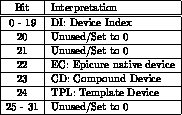
- NAME
- A 12 character fixed-length string, left justified padded with spaces.
- CLASS
- The device class code is returned as a longword integer where the least
significant byte contains the valid class code. The return class format and
codes are described and defined as:

- TEXT
- A byte of character count followed by up to 31 text characters. The character count
byte is not included in the count of text bytes, therefore static allocation for this
property should accommodate 32 bytes. The format is described below:

The READING, READING ALARM, SETTING, STATUS, STATUS ALARM, and CONTROL properties return
data formats are described by the return data format of the attributes that are associated
with these properties.
- SAVE/RESTORE
- A longword is returned with TRUE (1) if the property is present and
FALSE (0) if the property is not present for the device.
- BEAMLINE
- Both db_ & dbsa_ services return the BEAMLINE property beginning
with a length field that
specifies the size (in bytes) of the entire property. The count field follows and indicates
the number of beam line names that are associated with the particular device. The beam line
names are returned as an array of longwords terminated by a longword set to 0. The return
format is:
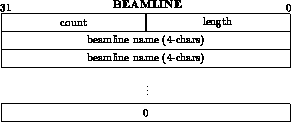
- LOCATION
- The location property is returned as:
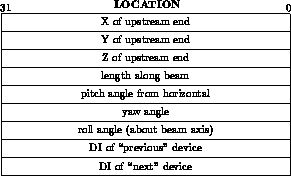
For the links, ``previous'' and ``next'' device are defined by the upstream end Z
coordinates. The devices with a location are thus tied into a single list ordered
by their upstream Z positions and permits devices to be located given a single device.
- DEVICETYPE
- This encoded property is returned as a longword integer and has
the following format:

The least significant word identifies the device type such as a BEND or QUAD magnet, etc. The
may also be used to select a symbol that represent the device on a map on display screens. The
type modifier is used to represent subtypes of a particular class of devices (for example, a
4-2-240 dipole or 3Q120 quadrupole).
- LIST
- The property is returned as a list of DIs which either form a COMPOUND device or
associate devices for a smart device. Both db_ & dbsa_ services return the LIST
property beginning with a length field that
specifies the size (in bytes) of the entire property. The count field follows and indicates
the number of DI that are in the list. The DIs are returned as an array of longwords terminated by
a longword set to 0. The return format is:
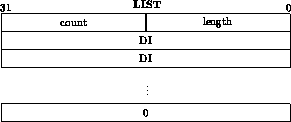
- TEMPLATETYPE
- A 12 character fixed-length string, left justified padded with spaces. This property
returns the name of the template used to create the device and is a secondary key which may be used
to access the device template located in the template database
 .
.
- MODULELOC
- A 4 character fixed-length text field returned as a longword integer. This property
specifies the location of the hardware, such as service building ``PS1''. The value returned may
represent the actual location of the device or an identifier which selects a text string description.
The field is left justified and padded with spaces.
- MODULETYPE
- A 4 character fixed-length text field returned as a longword integer. This property
specifies the hardware type, such as ``1032''. The value returned may represent the actual hardware
or an identifier which selects a text string description. The field is left justified and padded with spaces.
- DAPTYPE
- Returned as a longword integer. The encoded values are:

- XTEXT,HISTORY,CONTROLLERTYPE
- These properties are returned as a variable-length
block of text. The return data format is:

The count contains the number of text bytes following and is not inclusive. The
text field contains a descriptive text of the what the property represents and
is used for reporting purposes. The maximum that the field can contains is 80 characters.
- TPL_NAME_FORMAT
- This property is used only by template devices to
define the name format of devices associated with a particular device. The data format
of the property begins with a length field that
specifies the size (in bytes) of the entire property. The count field follows and indicates
the number of device names that are associated with the particular device. The names are defined
as an array of fixed-length strings. The return format is:
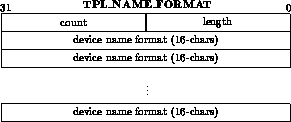
- ADDRESSING
- This attribute contains the Data Access Packet (DAP)
which returns the information needed by the data acquisition subsystem to access
the device. The attribute consists of two parts: a header consisting of data which
provides information for the DAE and a variable data portion which provides the
specific location of the given device. The return data format is:
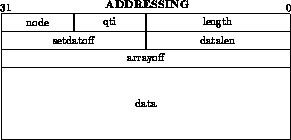
The length field contains the length of the addressing attribute inclusive. The
queue table index (QTI) field specifies which module in the VME crate is to
receive the DA list. Node field specifies which VME create to send the DA list to.
Datalen specifies the length, in bytes, of the read or set data. Setdataoff
specifies the offset for the ``setting'' data. Arrayoff specifies the data offset for
array devices. The data field represent the variable length data portion of the
attribute which contains the specific information for accessing the device ( i.e. crate,
slot, etc.).
- SIZE
- Returns a longword integer containing the size of the device and property data
returned by the data acquisition subsystem. The default and maximum return data sizes (in bytes)
are given in the

- SOURCECLASS
- A 6 character fixed-length string, left justified padded with spaces.
The source classes are:
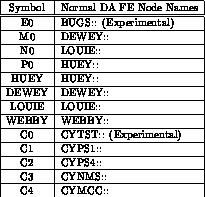
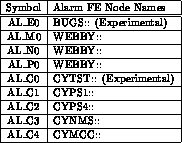
- RATE
- Returns information on the default sample rates (or times) for normal and plot
data acquisition. These defaults do not effect settings (write operations), but
do apply to the readback of the SETTING property. The return format is an array of FTD longwords:
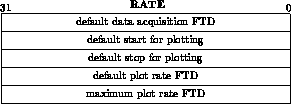
- SCALING
- The return data format for the scaling attribute is different for the individual properties. Refer
to the include header file dbuser.h located in the directory epicure_inc on the WARNER
cluster for specific formats of the scaling attributes.
- PROTECTION
- Both READ PROTECTION and WRITE PROTECTION attributes are returned as four longwords.
The pig_ service routines are used to read and write the protection codes.
- FUNCTION
- This attribute is used only for synthetic devices and specify the algorithm and constants
used to calculate the synthetic device quantity. The return data format is:
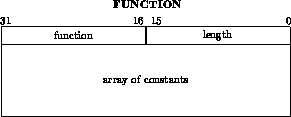
The length specifies the length of the attribute in bytes. Function specifies the
algorithm code. The array of constants are the floating point values used by the algorithm.
- BITNAMES
- The returned data contains a header and is followed by an array of bitnames. The return data
format is:
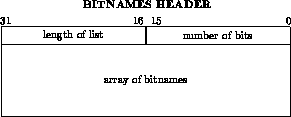
The length is in the bitname header and is the size of all the bitnames associated with that
attribute. The number of bits indicates the count of the bitnames.
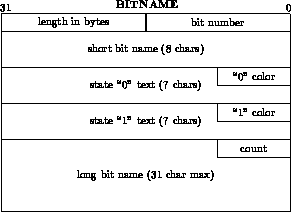
The valid range for the bit number is 0 to 31 or the maximum size of the STATUS data (or
7/15 for 8/16-bit data). The length field of the BITNAME is inclusive. The short
bitname is meant as the abbreviation of the long bit text.
- DISPLAY
- The return data format is:
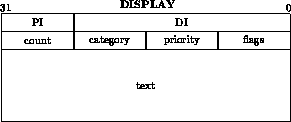
DI and PI fields specify the override device and property. Flags is a bit field
containing the logging enable flag. Priority is the for the display and category
selects the device category. Count field specifies the number of text bytes in the
following text field. The maximum that the field can contain is 32 characters.
- MODULETYPE
- A 4 character fixed-length text field returned as a longword integer. This attribute
specifies the hardware type, such as ``1151'', for a particular property. The value returned may represent
the actual hardware type of the device or an identifier which selects a text string description.
The field is left justified and padded with spaces.
- CTLNAMES
- Returns the bit masks of the CONTROL property in the format:
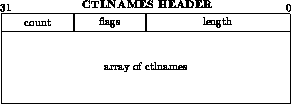
The only flag defined is DB_M_CTL_MERGE. If this flag is set, bit masks can be merged. Each
element of the array is of the format:

- DATAFORMAT
- A longword indicating the returned data format is returned. The encoded
values are:

- ALARMTYPE
- A longword indicating the alarm type is returned. The encoded
values are:

- MODULELOC
- A 4 character fixed-length text field returned as a longword integer. This attribute
specifies the location of the hardware, such as ``PS4'', for a particular device and property. The value
returned may represent the actual location of the device or an identifier which selects a text string description.
The field is left justified and padded with spaces.
Keywords: Epicure, program, database, DBSA, DBSAUTI, editor, OA, LAL, RMS, DBScanner
Distribution: normal
Security, Privacy, Legal
rwest@fsus04.fnal.gov
to connect to the server,
request database modifications, and build OA/LAL databases.
The system is distributed by placing multiple copies of the OA/LAL databases
on destinations about the network. Those destinations which require efficient access
for data acquisition have their own local copy; other ones can access the OA/LAL
resident on a ``nearby'' destination
.























